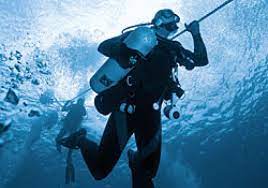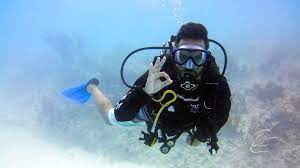The hydrostatic testing process for scuba tanks involves 5 key steps: 1) Visual inspection for cracks/dents (reject if depth exceeds 0.1 inch), 2) Filling with water to 90% capacity, 3) Pressurizing to 1.5 times working pressure (e.g., 3,000 psi tank tested at 4,500 psi) for 30 seconds, 4) Measuring permanent expansion (must be <10%), and 5) Stamp approval if passed, with 5-year validity. Tests ensure tanks can safely handle diving pressures.
Check for Damage First
Scuba tanks must be checked for dents, cracks, corrosion, or deep scratches—any of which can lead to failure under pressure. The maximum allowable dent depth is 0.1 inch (2.54 mm), and corrosion must not exceed 10% of the tank’s surface area. If a tank fails this inspection, it’s immediately rejected—no exceptions.
A go/no-go gauge is used to verify thread integrity—if the gauge doesn’t fit smoothly, the tank fails. Additionally, hydro test dates are checked; if a tank is overdue (beyond 5 years since the last test), it cannot be used until retested.
For example, a 3,000 psi aluminum tank that ruptures underwater can release energy equivalent to a small explosion, endangering divers. That’s why every scuba tank—whether new or used—must pass this step before proceeding.
The Hydrostatic Testing Process: Key Steps
Once a tank passes visual inspection, it moves to hydrostatic testing—a non-negotiable safety procedure required by DOT (Department of Transportation) and ISO standards. Here’s how it works:
-
Fill with Water (90% Capacity)
The tank is filled with water to 90% capacity—leaving 10% air space to allow for expansion. This prevents water hammer effects, which could damage the testing equipment. The water must be clean and free of debris to avoid false pressure readings.
-
Pressurize to 1.5x Working Pressure
The tank is placed inside a water-filled test chamber and pressurized to 1.5 times its rated working pressure. For example:
- A 3,000 psi tank is tested at 4,500 psi
- A 3,500 psi tank is tested at 5,250 psi
This pressure is held for 30 seconds—enough time to detect any weaknesses.
-
Measure Permanent Expansion
After depressurizing, the tank’s permanent expansion is measured. If the tank expands more than 10%, it fails. Most tanks expand between 3-6%—anything beyond that indicates metal fatigue.
-
Final Inspection & Stamping
If the tank passes, it receives a stamped marking near the neck, showing the test date and facility ID. This mark is legally required—without it, the tank cannot be legally filled or used.
-
Valve & O-Ring Check
Even if the tank passes, the valve and O-rings must be inspected. A leaking valve can cause slow pressure loss, making the tank unsafe for diving.
Cost & Frequency: Hydrostatic testing typically costs 50 per tank and must be done every 5 years (or after any major impact).
Failure Rate: Approximately 2-5% of tanks fail hydrostatic testing—usually due to corrosion or metal fatigue.
Fill with Water Safely
The tank must be filled to 90% capacity, leaving 10% air space to prevent water hammer, a dangerous pressure surge that can damage equipment. The water used must be filtered and debris-free—even small particles can throw off pressure readings by 1-3%, leading to false results.
The filling process is done slowly, at a rate of about 1 gallon per minute (3.8 liters/min) to avoid air pockets, which can compress during testing and skew expansion measurements. If air remains inside, it can cause up to a 5% error in the final expansion reading, potentially leading to a false pass or fail.
A poorly filled tank can waste time and money—if a test has to be repeated due to improper filling, it adds $15-25 in extra labor costs. Worse, an incorrectly filled tank might hide structural weaknesses, putting divers at risk.
The Right Way to Fill a Scuba Tank for Hydro Testing
Water Quality Matters
If the water is too hard (above 50 ppm calcium carbonate), it can leave deposits inside the tank, affecting future air fills. Some test facilities use deionized water to ensure purity, which costs 1.00 per gallon but prevents contamination.
Fill Level Precision
The 90% fill rule isn’t arbitrary—it’s based on decades of pressure vessel testing. If a tank is filled to 95% or more, the remaining air space is too small to absorb expansion, increasing the risk of pressure spikes during testing. Conversely, filling to less than 85% leaves too much air, making expansion measurements unreliable.
Temperature Control
The ideal range is 60-80°F (15-27°C). If the water is too cold (below 50°F/10°C), it can cause metal contraction, leading to false expansion readings. If too hot (above 90°F/32°C), it may weaken the tank temporarily, masking flaws.
Common Mistakes & Fixes
-
Air pockets – If trapped air is suspected, the tank should be tapped lightly while filling to dislodge bubbles.
-
Overfilling – If accidentally overfilled, the tank must be partially drained to hit the 90% mark.
-
Contaminated water – If debris is found, the tank must be flushed and refilled, adding 5-10 minutes to the process.
Cost of Errors
-
A failed test due to improper filling means $30-50 in retesting fees.
-
A falsely passed tank (due to air pockets) could lead to catastrophic failure underwater.
Final Check Before Pressurizing
Before moving to the pressure phase, the technician verifies:
-
No visible air bubbles when shaking the tank.
-
Water clarity—cloudy water means possible contamination.
-
Fill level accuracy—measured with a calibrated dip tube or sight glass.
Bottom Line: Always follow the 90% rule, use clean water, and double-check before pressurizing.

Pressurize to Test Limits
The most critical phase of hydrostatic testing is when the tank is pressurized to 1.5 times its working limit—a make-or-break moment that determines whether the tank is still safe for diving. For a standard 3,000 psi aluminum tank, this means ramping up to 4,500 psi, while a high-pressure 3,500 psi steel tank gets pushed to 5,250 psi. This 30-second pressure hold isn’t arbitrary—it’s the minimum time needed to expose hidden weaknesses like microcracks or metal fatigue.
The pressure is increased at a controlled rate of 500 psi per second—too fast, and stress fractures might go undetected; too slow, and the test becomes inefficient.
A tank that fails at 4,500 psi in the lab could explode at just 2,000 psi underwater, putting divers in immediate danger. That’s why this step is non-negotiable—no shortcuts, no exceptions.
How Pressurization Testing Works
The Equipment Matters
Not all test rigs are equal. A certified hydrostatic test system must have:
-
Digital pressure gauges accurate to within ±1%
-
Automatic shutoff valves that trigger if pressure exceeds 110% of test limit
-
High-speed data logging to track pressure changes every 0.1 seconds
Cheap or outdated equipment can give false readings, which is why reputable test facilities invest 50,000 in their hydrostatic rigs.
The Pressure Curve Tells the Story
If the pressure fluctuates by more than ±50 psi during the hold period, it suggests:
-
A slow leak (often from valve threads)
-
Metal yielding (the tank is stretching beyond its elastic limit)
Common Failure Modes
-
Sudden pressure drop (>100 psi in <1 sec) = Catastrophic rupture (rare, <0.1% of tests)
-
Gradual pressure loss (5-10 psi over 30 sec) = Microleak or porous metal (2-3% of tests)
-
No pressure drop but high expansion (>10%) = Metal fatigue (1-2% of tests)
What Happens If a Tank Fails?
-
Immediate condemnation – The tank is marked with an "X" or drilled to prevent reuse.
-
No refunds – The $30-50 test fee is non-refundable since the service was performed.
-
Mandatory reporting – In some regions, failed tanks must be reported to safety authorities.
Safety Margins Are Tight
The 1.5x multiplier isn’t random—it’s based on decades of metallurgy research. For example:
-
Aluminum tanks (6061-T6 alloy) have a burst strength of ~6,000 psi, so testing at 4,500 psi leaves a 25% safety margin.
-
Steel tanks (DOT-3AA) burst at ~7,500 psi, so 5,250 psi testing keeps a 30% buffer.
Human Factors Matter Too
Even with perfect equipment, technician errors cause 15% of false failures. Common mistakes:
-
Over-pressurizing by 50-100 psi due to gauge misreading
-
Starting the timer too early/late, skewing the 30-second hold
-
Ignoring ambient temperature (cold tanks show higher expansion)
Measure Expansion Precisely
After pressurizing a scuba tank to 1.5 times its working limit, the next critical step is measuring permanent expansion—the tiny but telling deformation that reveals whether the tank’s metal has weakened over time. The industry standard allows no more than 10% permanent expansion, meaning a standard 80 cubic foot aluminum tank (original volume: 0.49 gallons) can’t grow by more than 0.049 gallons after testing.
This measurement isn’t guesswork—it’s done with laser micrometers or water displacement systems accurate to ±0.1%. Even a 0.5% overexpansion (just 0.0025 gallons on that same tank) can indicate early-stage metal fatigue, which might not fail today but could rupture after 100-200 more fills.
A tank that expands 11% might still hold pressure during testing, but its safety margin is gone. At depth, where temperatures drop and stresses increase, that extra 1% over the limit could be the difference between a normal dive and a catastrophic failure.
The Science Behind Expansion Measurement
How Expansion Happens
In aluminum tanks, this typically shows as 3-6% expansion, while steel tanks usually expand 2-4%. If a tank hits 8-9%, it’s nearing retirement—even if it passes this test, it likely has less than 5 years of safe use left.
Measurement Methods Compared
|
Method |
Accuracy |
Cost |
Speed |
Best For |
|---|---|---|---|---|
|
Water displacement |
±0.05% |
5,000 |
2 min/tank |
High-volume test shops |
|
Laser micrometer |
±0.1% |
15,000 |
45 sec/tank |
Precision-focused labs |
|
Caliper manual |
±1.0% |
1,000 |
5 min/tank |
Low-budget operations |
The tank is submerged in a calibrated cylinder, and the displaced water volume is measured to 0.001-gallon precision.
Real-World Expansion Data
-
New aluminum tanks: Typically expand 2.8-3.5% on first test
-
5-year-old steel tanks: Average 3.1-4.2% expansion
-
Failed tanks: Usually show 10.5-12% expansion before rejection
Temperature’s Hidden Effect
Metal expands with heat, so tests must account for ambient temperature:
-
For every 10°F (5.5°C) above 70°F, measured expansion increases by 0.3%
-
Below 50°F (10°C), aluminum contracts enough to hide 0.5-0.8% expansion
That’s why DOT standards require testing at 60-80°F (15-27°C)—outside this range, corrections must be applied.
What Happens to Failed Tanks?
-
Condemned immediately with a 1/2-inch drill hole through the neck
-
Scrapped for 0.50/lb (aluminum) or 0.20/lb (steel)
-
Never repurposed—even as decorative items, they’re banned in most states
Human Errors That Skew Results
-
Not letting tanks stabilize (needs 3-5 mins post-pressure release)
-
Using dirty water in displacement systems (adds 0.2-0.5% error)
-
Misreading gauges by just 1 psi can throw off calculations by 0.05%
Bottom Line: A 9.5% expansion tank might pass today, but smart divers retire them early. Always check test reports for exact expansion percentages, not just pass/fail stamps.
Stamp & Record Results
Every passing tank receives a stamped marking near the neck, typically showing the test date (e.g., "08-25" for August 2025), the facility’s ID code (like "R123"), and sometimes the inspector’s initials. This stamp isn’t optional—without it, dive shops won’t fill the tank, and using one without a current stamp violates DOT/ISO regulations in most countries.
The stamp must be clear and permanent, applied with a steel die pressed at 50-100 psi to ensure it doesn’t wear off. Faded or incomplete stamps force retesting, costing the owner another $30-50. Alongside the stamp, test details are recorded in a bound logbook (required by law for 5+ years) with the tank’s serial number, test pressure, expansion percentage, and any notes—like minor corrosion that doesn’t yet disqualify it but warrants monitoring.
If a tank fails underwater and the last test wasn’t properly documented, the testing facility could face $10,000+ in fines or lawsuits.
The Nuts and Bolts of Tank Certification
Stamp Specifications
-
Size: Typically 1/4 inch (6 mm) tall characters
-
Depth: 0.003-0.005 inches (0.07-0.12 mm) into the metal
-
Location: Within 2 inches (5 cm) of the tank neck’s base
-
Legibility: Must remain readable after 500+ fills
Record-Keeping Requirements
Testing facilities must store:
-
Tank serial number (e.g., "AL6061-8472")
-
Test date (month/year format)
-
Test pressure (e.g., "4500 psi")
-
Expansion percentage (e.g., "4.2%")
-
Inspector’s name/signature
These records are kept for 5-7 years, depending on local laws, and must be produced within 48 hours if authorities request them.
The Cost of Poor Documentation
-
Illegible stamps lead to 15-20% of tank rejections at dive shops
-
Missing logbook entries can void a facility’s certification ($5,000 renewal fee)
-
Fraudulent stamps (e.g., backdating) carry $25,000+ fines per incident
How Often Stamps Fail
-
5% wear off prematurely due to improper application
-
3% are misaligned or double-stamped (requires correction)
-
1% contain errors (wrong date/code) needing overstamping
Digital vs. Paper Tracking
While 90% of test shops still use paper logs, modern facilities are switching to barcode systems:
- Barcode cost: 1.00 per tank (vs. $0.05 for manual entry)
- Error rate: Drops from 2% to 0.1% with barcodes
- Search speed: Finds a tank’s history in 3 seconds vs. 5+ minutes
What Divers Should Check
Before accepting a tested tank:
- Verify the stamp matches the paperwork (dates/codes align)
- Ensure no "X" or drill marks (signs of prior failure)
- Confirm the next test date (e.g., "+5" means valid until 2030)





اترك تعليقًا
تخضع جميع التعليقات للإشراف قبل نشرها.
This site is protected by hCaptcha and the hCaptcha Privacy Policy and Terms of Service apply.